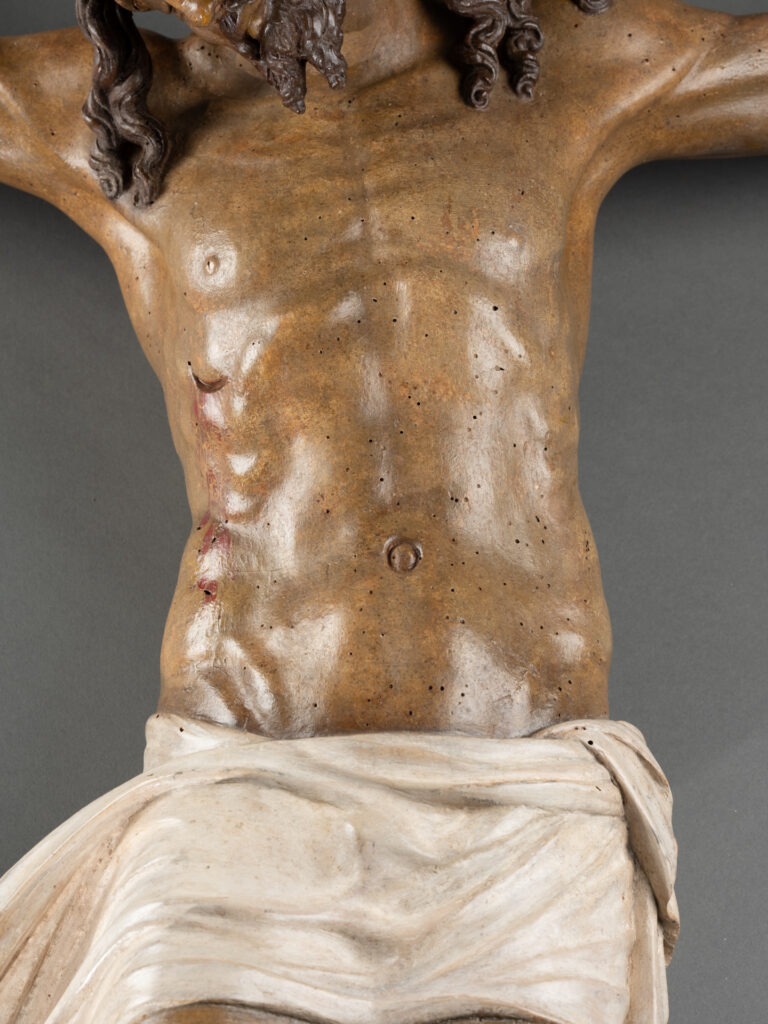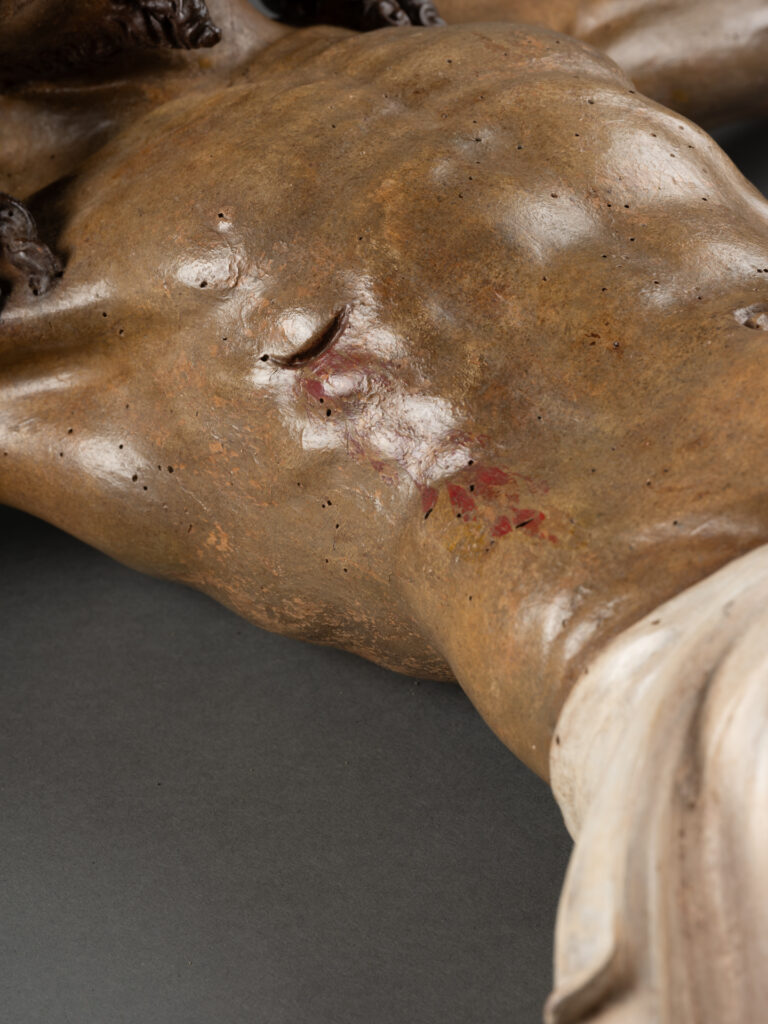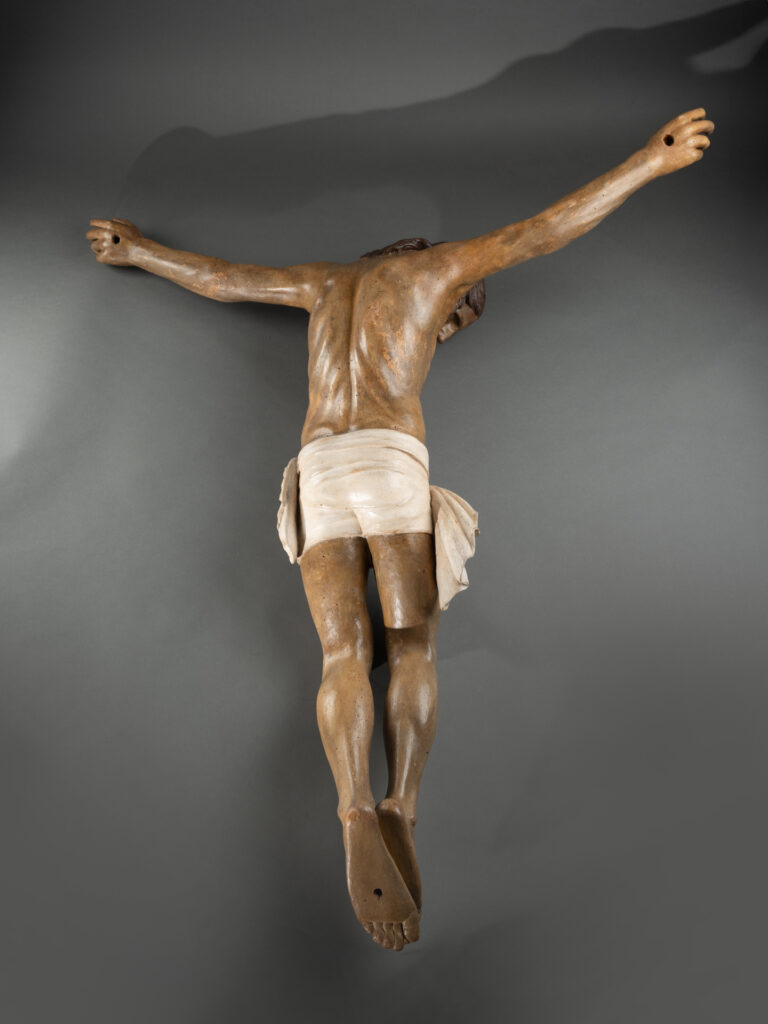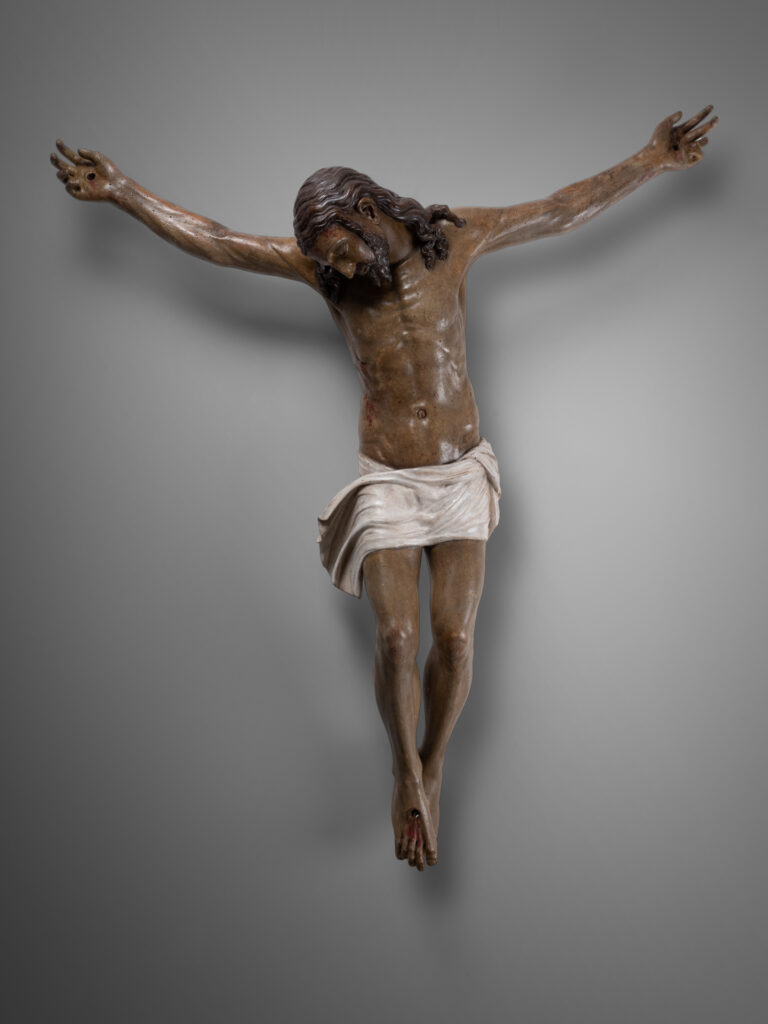This splendid sculpture of Christ on the Cross, dating from the very end of the 15th century, is of rare finesse. This representation was a common topos during the Renaissance, and many artists tried their hand at it. We are going to present the work of a few artists who have enabled us to better understand the influences of the various representations, and who subsequently allow us to affirm that this work comes from a Florentine workshop.
Most of these Christs are made of wood or bronze, and can be found all over Europe. The first revolution began with Giotto’s painting of the crucifix, which broke away from the Byzantine tradition. Brunelleschi then created a sculptural version, which historian Luciano Bellosi describes as the first Renaissance-style work in the history of art.
Pisano made a wooden version in which he tilted his head to one side, but Christ’s perizonium is longer than Brunelleschi’s, who had decided to depict Christ naked and add a fabric perizonium on top.
As for Donatello, he made two very different versions of Christ, the first in wood but of medieval inspiration, its wooden perizonium very long and covering one knee, leaving the other apparent in a kind of forward movement. Whereas his second sculpture is in bronze, made to adorn the cathedral of St. Anthony of Padua, this time the Christ is muscular, the proportions of his body are not the same and are more realistic than his wooden sculpture. Its bronze perizonium is very short, so we can see that sculptural trends are evolving rapidly.
In the last quarter of the 15th century, a number of large family workshops in Italy specialized in the creation of crucifixes. The orders were for churches, but also for private places of worship. This mainly took place in and around Florence. These families include the Del Tasso family (Fransceco and Leonardo), the Sangallos (Giuliano, Antonio il Vecchio and Francesco) and the brothers Giuilano and Benedetto da Maiano.
Michelangelo made a crucifix that can be seen in Florence’s Bargello museum. This artist, like Donatello, was the master thinker of his time, and so other artists were inspired by his work. That’s why we can see many similarities with our work, such as the treatment of the musculature.
A crocifisso that resembles ours in the general shape of the body is that made by Benedetto da Maiano. Both have their heads almost in line with their arms, and are muscular, with ribs showing in places. Their knees are slightly bent and their feet are one on top of the other each time. The major difference is that Benedetto da Maiano made his Christ nude so that he could add a fabric perizonium on top.
Giuliano da Sangallo, a Florentine artist, also devoted himself to the art of crucifissi. His most famous can be seen at Villa Quiete, near Florence. What’s remarkable in this work is the treatment of the body, which is very realistic: we can see tendons as well as muscles and ribs on the torso, armpits and also on the shins. He’s made of wood, but his perizonium is fabric and his wavy hair is openwork.
In our case, the polychromy is original, he’s quite tall and the proportions and musculature are quite realistic. The sculpture is in the shape of a round hump, with all sides carved out – a deliberate choice on the part of the artist, who could have chosen not to carve the back of the figure, as his back against a cross is not visible, thus demonstrating his virtuosity.
It’s made up of three parts: the body and each arm, but the arms aren’t articulated like some models.
Its perizonium is made of wood; on one side, the drapery is straight, a tradition and aestheticism corresponding to the medieval period, while on the other side, it seems to float somewhat in a movement typical of the Renaissance.
His head, lowered and turned to the right, is almost in line with his arms. He doesn’t seem to be wiggling, or writhing in pain, though a slight contrapposto is visible due to the posture of his knees. Her hair is highly worked and openworked, parted in curly locks that reveal her ears. This is a rare occurrence, since most of the time, artists don’t show their Christ’s ears. However, the one on the left is finely carved, while the one on the right is just the general shape, without being carved. His beard, a symbol of wisdom, is divided into two parts. Leonardo del Tasso, a late 15th-century sculptor in Florence, fashioned the beards of his Christs in the same way.
His eyes are half-open and his mouth is closed, proof that he has just exhaled his last breath. The slim nose accentuates the deep-set eyelids. He bears the stigmata of the crown of thorns, which we can see through the bleeding on his forehead.
Her hands are exceptionally graceful, her fingers long and slightly tense, and her nails exceptionally fine. The skin around her nails covers them, giving an impressive realism. The same phenomenon can be seen on his feet, where the skin folds over the spot where the nail was supposed to be. The artist has paid attention to every detail of his work to make it as realistic as possible.
As for his body, his back, arms and torso are slightly muscled, but his ribs remain visible, particularly at the back, to reproduce the tension of the body during the crucifixion. His legs are bent forward and his feet are glued together.
There are three types of representations of Christ:
-The Christus triumphans that we find as early as the 5th century.
-The Christus patiens, which appeared in the 10th century.
-The Christus dolens, of which ours is one, appeared during the Renaissance, in which the figure of Christ is depicted with his eyes closed, his head resting on his shoulder and wounds still visible, such as the wound on his right flank caused by the Roman centurion’s spear.
We can sense the humanist movement in this sculpture, which places Man and his values at the center of thought, with Man above the divine.
With all these examples of similar works, we understand that the artist who made our work must have lived in Tuscany and frequented the studios of these various artists to draw inspiration for his masterpiece.





